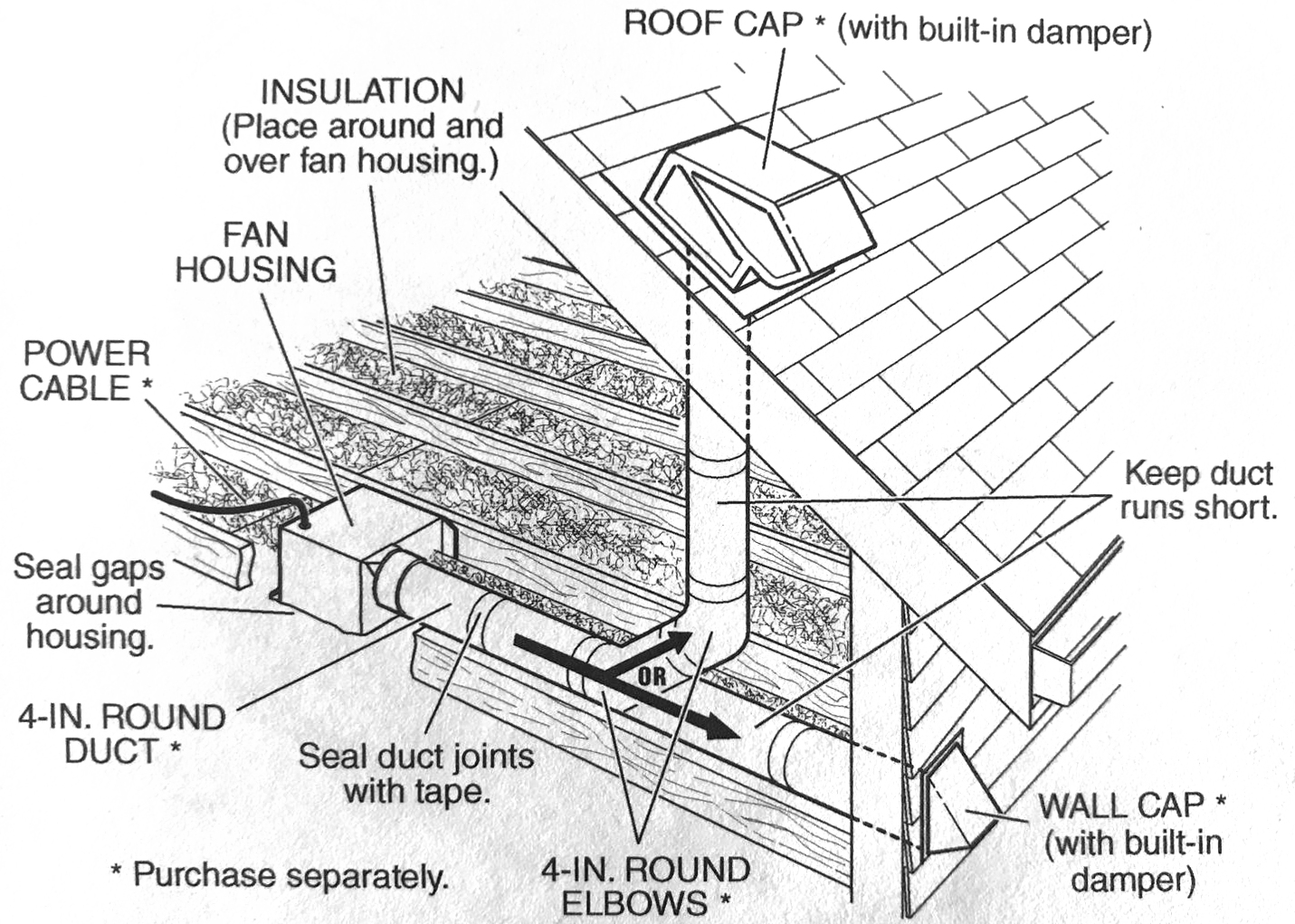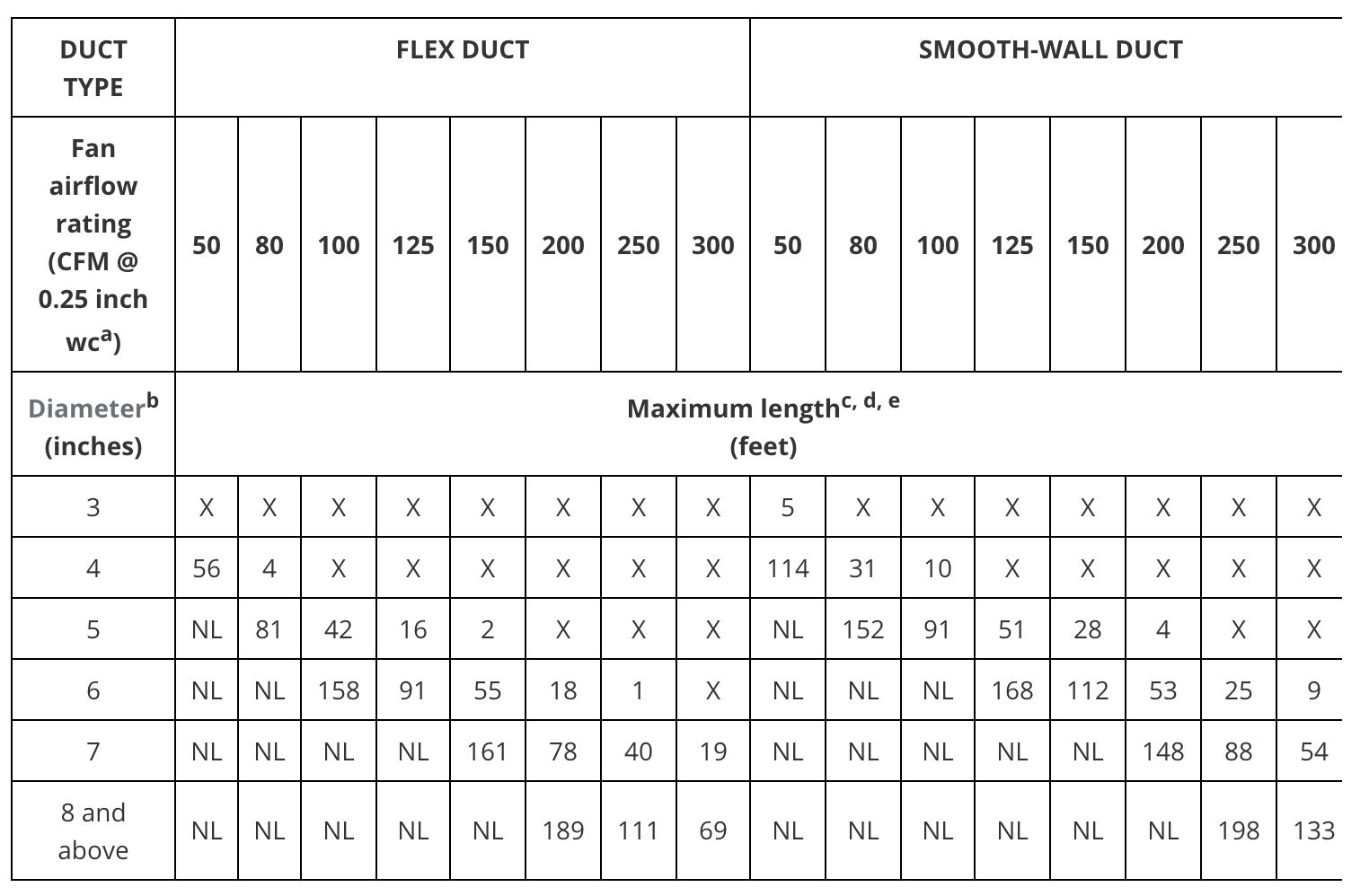Duct Length Calculations

Bathroom exhaust fan duct length – Calculating the maximum allowable duct length for a bathroom exhaust fan is essential to ensure optimal performance and prevent issues like backdrafting. The formula to calculate the maximum duct length is:
Duct Length = (CFM x 100) / (Friction Loss per 100 ft)
where:
- CFM is the fan’s airflow capacity in cubic feet per minute (CFM)
- Friction Loss is the pressure drop per 100 feet of duct, which depends on the duct diameter and material
Factors that affect the maximum duct length include:
- Fan CFM: Higher CFM fans can push air through longer ducts
- Duct Diameter: Wider ducts have lower friction loss, allowing for longer runs
- Number of Elbows: Each elbow increases friction loss, reducing the maximum duct length
Example Calculations
For a bathroom with a 100 CFM fan and 6-inch diameter duct with a friction loss of 0.15 inches of water column (WC) per 100 feet, the maximum duct length would be:
Duct Length = (100 CFM x 100) / (0.15 WC per 100 ft) = 666.67 feet
Speaking of ventilation, did you know that the length of your bathroom exhaust fan duct can affect its efficiency? But hey, let’s not get bogged down in technicalities. Instead, let’s talk about something more exciting, like horse wallpaper. Can you imagine your bathroom walls adorned with majestic steeds galloping across the plains?
Now, back to our duct length discussion…
If the same fan were used with a 4-inch diameter duct with a friction loss of 0.25 WC per 100 feet, the maximum duct length would be:
Duct Length = (100 CFM x 100) / (0.25 WC per 100 ft) = 400 feet
Bro, you know what else is important for a bathroom? The exhaust fan duct length! It’s like, the longer the duct, the less noise you’ll hear. But then again, if it’s too long, it might not be as effective. It’s like the firewatch wallpaper in my bathroom – it looks cool, but it’s not exactly practical.
So, when it comes to bathroom exhaust fan duct length, find a balance, dude!
Duct Design Considerations: Bathroom Exhaust Fan Duct Length

Yo, what’s up bathroom ventilation enthusiasts? We’ve been talking about duct length and now let’s dive into the juicy stuff – duct design considerations. Trust me, this is not just some boring technical jargon; it’s the key to making sure your bathroom smells like a spa, not a locker room.
First off, let’s chat about duct size. It’s like the highway for your fan’s airflow. If you use a duct that’s too small, it’s like trying to squeeze a truck through a bike lane – not gonna happen. The airflow will get all choked up and your fan will have to work harder, making more noise and using more energy. So, make sure you match the duct size to the fan’s CFM (cubic feet per minute). It’s like matching your shoes to your feet – you want a snug fit, but not too tight.
Now, let’s talk about duct materials. You’ve got a few options here:
- Flexible duct: This stuff is like the yoga pants of ducts – it’s flexible and easy to work with, but it can be a bit noisy and it’s not as durable as other options.
- Semi-rigid duct: This is a good middle ground – it’s more durable than flexible duct, but still easy to bend and shape. It’s also quieter than flexible duct.
- Rigid duct: This is the most durable option, but it’s also the hardest to work with. It’s usually made of metal and requires special tools to cut and bend.
Which one should you choose? It depends on your budget and your DIY skills. If you’re on a tight budget and you’re comfortable working with flexible duct, go for it. If you want something more durable and quieter, semi-rigid duct is a good choice. And if you’re a pro and you want the best of the best, go with rigid duct.
Finally, let’s talk about noise reduction. Nobody wants a bathroom that sounds like a jet engine. Here are a few tips to keep the noise down:
- Use a duct silencer. This is a device that you can install in the duct to absorb sound.
- Make sure the duct is properly sealed. Any gaps or leaks will let noise escape.
- Use a fan with a low sone rating. Sones measure the loudness of a fan, so the lower the sone rating, the quieter the fan.
And that’s it, my friends! With these duct design considerations, you can create a bathroom exhaust system that’s quiet, efficient, and smells like a tropical paradise. Go forth and conquer the bathroom odor!
Installation Best Practices

Installing a bathroom exhaust fan duct is a straightforward process that can be completed in a few simple steps.
- Plan the duct route: Determine the path the duct will take from the fan to the outside vent. Keep the duct as short and straight as possible to minimize airflow resistance.
- Cut the duct to length: Measure the length of the duct run and cut the duct to size using a utility knife or duct shears.
- Connect the duct to the fan: Attach the duct to the exhaust fan using a duct connector. Seal the connection with duct tape to prevent air leaks.
- Run the duct to the outside vent: Route the duct through the attic or crawlspace to the outside vent. Secure the duct to the framing using duct straps or hangers.
- Connect the duct to the vent: Attach the duct to the outside vent using a vent cap. Seal the connection with duct tape to prevent air leaks.
Sealing Duct Joints, Bathroom exhaust fan duct length
It is important to seal all duct joints to prevent air leaks. Air leaks can reduce the efficiency of the exhaust fan and allow moisture to enter the ductwork. Use duct tape or mastic sealant to seal all joints.
Proper Ventilation
The exhaust fan duct must be properly vented to the outside. This means that the duct must not terminate in the attic or crawlspace. Venting the duct to the outside will allow the exhaust fan to remove moisture and odors from the bathroom.